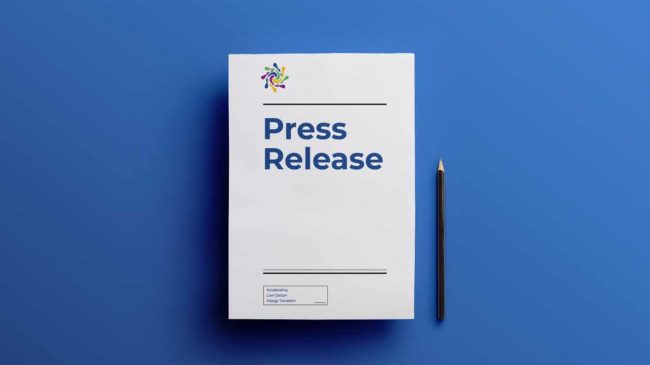Jakarta, December 5, 2023 – A significant reduction in emissions from the transportation sector is a strategy to achieve zero emission by 2050 per the Paris Agreement, or net zero emission (NZE) by 2060, as the Government of Indonesia targets. To turn this commitment into an actionable strategy, developing a comprehensive roadmap for decarbonizing the transport sector is essential.
The Institute for Essential Services Reform (IESR) has developed a roadmap for transport sector decarbonization policy at the national and regional (Jabodetabek) levels. Based on IESR data, the transportation sector, particularly land transportation, is responsible for increasing greenhouse gas emissions in Indonesia. Land transportation passenger movement accounts for 73% or 110 mtCO2e of total transportation emissions in 2022.
“Indonesia has updated its emission reduction target in the Enhanced Nationally Determined Contribution (ENDC). However, emission reduction is not only based on percentage; it must be aligned with the Paris Agreement. To achieve this, IESR has conducted roadmap modeling of transportation sector decarbonization opportunities with national and Jabodetabek regional model structures. This modeling aims to find the optimal steps that can be taken to increase Indonesia’s climate change mitigation actions,” said IESR Executive Director Fabby Tumiwa.
Rahmi Puspita Sari, IESR Sustainable Mobility Analyst, explained that the number of registered vehicles in 2021 has grown faster than the population rate across the country. Motorcycles make up the majority of registered vehicles, accounting for around 84.54% of the total number of cars in the country. This trend is also observed in the Jabodetabek region, where 75.8% of transportation modes used in 2019 were motorcycles, according to the Jabodetabek Urban Transportation Policy Integration (JUTPI) report. The reason for this dominance is the growth of the Indonesian economy, increased purchasing power, and the relatively low cost of motorcycles.
“Currently, we do not have public transportation that can compete with motorcycles in terms of price and time. This is concerning as motorcycles emit more pollutants than cars due to incomplete combustion. Additionally, two mobility phenomena contribute to the traffic in Jakarta. The first is commuter mobility, where people travel between zones from outside Jakarta to Jakarta for work or education, accounting for about 10% of trips in Jakarta. The second is circular mobility, where semi-permanent residents in the city return to their hometowns or travel for holidays on an annual basis,” Rahmi explained.
IESR examined vehicle and passenger movement policies in the transportation decarbonization roadmap modeling. Nationally, based on the principles of avoid (avoid and reduce travel), shift (switch to low-carbon vehicles), and improve (increase energy efficiency), five policies were tested to reduce emissions in the transportation sector. The five policies are working from home, concentrating travel on public transportation, using biofuels, setting a minimum amount of motor fuel efficiency (fuel economy standard), and providing incentives for electric motor vehicles and cars.
Fauzan Ahmad, Tasrif Modeling Team, who was also involved in creating the transportation decarbonization roadmap, said that the results of the policy testing indicate that transportation emissions can be reduced by 15% to 75% until 2060. This can be achieved through work-from-home policies, electric vehicles, biofuel use, public transportation use, and fuel efficiency. However, it is important to note that these reductions are mainly driven by passenger vehicle policies and not yet freight vehicles and road logistics.
“Electric vehicle policies have the potential to reduce national emissions significantly. However, two key factors must be addressed to achieve this goal to have an impact at the national level, namely an increase in the sales share of electric vehicles (EV sales share) and policy support that encourages a reduction in the number of fuel vehicles (ICE) that are not eligible to operate (discard rate). In addition, shifting modes towards public transportation has a more sustainable impact on fuel and resource use but requires considerable investment,” Fauzan explained.
While in the Jabodetabek region, using the principles of avoid, shift and improve, there are seven policies tested on the transportation decarbonization road map, namely development planning around public transportation (Transit Oriented Development, TOD), work from home (WFH), imposing restrictions on high-emission vehicles (Low, Emission Zone, LEZ), concentrating on public transportation, using biofuels, setting a minimum amount of motorized fuel efficiency (fuel economy standard) and providing incentives for electric motor vehicles and cars.
Arij Ashari Nur Iman, Tasrif Modeling Team, mentioned that the results of policy testing at the regional level showed a decrease in transportation emissions of around 7%-43% annually from the baseline scenario in the 2010-2060 timeframe through a combination of WFH, LEZ, TOD, electric vehicles, biofuels, use of public transportation, and fuel efficiency policies.
“Establishing low-carbon policies can reduce emissions by up to 45%. The most significant policy is establishing a minimum motorized fuel efficiency, using biofuels, prioritizing public transportation, and promoting electric vehicles,” Arij explained.

